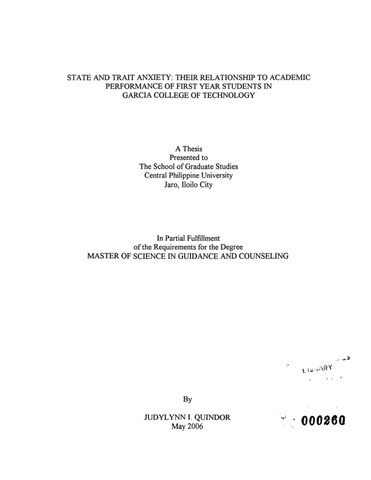State and trait anxiety: Their relationship to academic performance of first year students in Garcia College of Technology
Аннотации
This study aimed to determine the relationship of the level of state and trait anxiety to the academic performance of first year college students in Garcia College of Technology in Kalibo, Aldan, during the second semester of the academic year 2005- 2006. The respondents of this study were 212 first year college students selected through multi-stage random sampling from the population of473 first year college students enrolled in the four and five year degree programs in the college. The respondents were classified according to sex, birth order, living arrangement while studying in Garcia College of Technology, type of high school graduated from, and high school average grade.
This study collected data on level of state and trait anxiety using the State-Trait Anxiety Inventory by Speilberger et. al. (1983). This instrument was divided into two parts; the S-Anxiety scale which consisted of twenty statements that evaluated how respondents feel “right now, at this moment”, and the T-Anxiety scale which also consisted of twenty statements that assessed how respondents feel “generally”. The respondents responded to each question in a four-point likert scale, indicating the frequency with which each strategy is used. The researcher conducted the inventory personally.
A separate questionnaire on personal characteristics of the respondents was also used to determine the respondents’ sex, birth order, living arrangement and type of high school graduated from. Data on high school average grade was obtained from the guidance office and general weighted average during the first semester AY 2005-2006 from the office of the College Registrar.
The data gathered were encoded using Excel software and processed for data analysis using Statistical Package for Social Sciences (SPSS). The level of significance adapted was .05.
In consonance with the objectives of the study, it was hypothesized that the level of state and trait anxiety of the first year students do not significantly vary according to sex, birth order, living arrangement, type of high school graduated from and high school average grade. It was also hypothesized that academic performance of the first year students do not significantly vary according to sex, birth order, living arrangement, type of high school graduated from, and high school average grade. Furthermore, it was hypothesized that there is no significant relationship between the level of state anxiety and academic performance and there is no significant relationship between the level of trait anxiety and academic performance.
Major
Findings Most of the first year students of Garcia College of Technology were females and slightly more than two-fifths of them were middle children. Most of them were living with parents and 39.6 percent of them graduated from national high school located in the poblacion. Exactly three-fourths of respondents had average high school average grade and more than one-half have average academic performance.
The first year students had an “average” level of state anxiety and almost an equal number of respondents have high, average, and low levels of state anxiety.
The male students obtained a slightly higher level of state anxiety than the female students, but the difference is not statistically significant which means that male and female students experienced almost the same level of state anxiety. In relation to type of high school graduated from, those who graduated from private high school got the highest mean level of state anxiety, while those who came from national high school poblacion obtained the lowest average. The ANOVA test result, however show no significant variation in the students’ level of state anxiety mean scores according to type of high school graduated from. The same finding was noted when level of state anxiety was examined according to birth order, and living arrangement. The score advantage of those who were youngest over those who were middle children and the eldest children in the mean level of state anxiety did not reach a significant level. The respondents’ level of state anxiety did not also vary according to living arrangement. The mean level of state anxiety of those who were living in boarding houses/or apartments was higher than the level of those who were living with parents or those who were living with guardian. The ANOVA result however shows that the differences between means were not significant at 5 percent level. Likewise, no significant differences were noted in the level of trait anxiety of the respondents when classified according to sex, birth order, and type of high school graduated from, living arrangement, and high school average grade.
In relation to high school average grade, those who have “low” high school average grade had the highest mean level of state anxiety score compared to those who had “average” high school average grade and those with “high” high school average grade. The difference among the means was statistically significant at 0.05 level. Moreover the Scheffe Test revealed a significant result in the level of state anxiety of the respondents with “high” high school average grade and those with “average” high school average grade. However, no significant variation was noted in the mean level of state anxiety of respondents’ with “high” high school average grade and those with “low” high school average grade; and those with “average” high school average grade and those with “low” high school average. This means that the first year students’ high school average grade has a significant bearing on the level of state anxiety.
In level of trait anxiety, the females obtained higher mean score than the males, but the difference among the means were not statistically significant. This means that the male and female respondents experience almost similar level of trait anxiety. The same finding was noted when variation in level of state anxiety according to type of high school graduated from, birth order, living arrangement and high school average grade was tested.
The first year students generally had “average” academic performance. Female students performed better than the males as shown in the mean academic performance of the female respondents, which is slightly higher than that of the males. The variation between means was significant at 5 percent level. However, respondents’ academic performance was found not to vary when classified according to type of high school graduated from, birth order, and living arrangement.
The Pearson r Correlation Coefficient revealed a moderate positive and significant correlation between level of state anxiety and academic performance of first year students. The result indicates that as the respondents’ level of state anxiety increases, their academic performance also increases. However, a negative but not significant correlation existed between the level of trait anxiety and academic performance of the respondents.
Conclusions
On the basis of the findings of this study, it is reasonable to conclude that:
Most of the first year students have average level of state anxiety while an almost equal number of them experience high, average, and low level of trait anxiety.
The high school average grades significantly influence the first year students’ level of state anxiety. Students’ with “high” high school average grade and those with “average” high school average grade are more likely to experience different levels of state anxiety, than those with “high” high school average grade and “low” high school average grade; and those with “average” high school average grade, and “low” high school average grade.
First year students’ sex and high school average grade significantly influence their academic performance. Females are more likely to perform better than the males. Students with “high” high school average grade are more likely to perform better than those with “average” high school average grade and those with “low” high school average grade.
The first year students’ academic performance has a positive and significant relationship with the level of state anxiety. As their level of state anxiety increases, their academic performance also increases. On the other hand, their level of trait anxiety has a negative but not significant relationship with academic performance. This means that their trait anxiety does not have a significant bearing on performance.
Recommendations
The foregoing findings and conclusions lead to the following recommendations:
Since students’ academic performance is a primary criterion of learning and achieving in schools, educators need to recognize how state anxiety influence academic performance. Teachers should first know more about this kind of anxiety so they can identify what situations in the classroom can cause anxiety among students.
First year students should be oriented / informed about their level of state anxiety so that they will be aware of its possible influence on their academic performance. School counselors can help by interviewing anxious students to identify what factors contribute to their anxiety. Counselors can suggest ways on how anxiety could become a motivation for good academic performance. They can also suggest anxiety reduction techniques like hypnotherapy or games. Counselors can inform instructors as well to make the factor that causes anxiety to students known to the instructor.
Schools should extend special assistance to first year students especially to those who were poor performers in high school like study groups, tutorials among others since it was found that high school average grade influence academic performance.
Описание
Abstract only
Suggested Citation
Quindor, J. I. (2006). State and trait anxiety: Their relationship to academic performance of first year students in Garcia College of Technology (Unpublished Master's thesis). Central Philippine University, Jaro, Iloilo City.
Type
ThesisТематика
Keywords
Department
School of Graduate StudiesDegree
Master of Science in Guidance and CounselingShelf Location
GSL Theses 371.4072 Q43
Physical Description
xviii, 98 leaves



